At the moment, the TWS headphone market is full of various models for any price tag and functionality. But each new version of the headset, for the most part, is a copy of the previous one with minor changes. Innovations relate to improving the quality of materials and assembly, adding new features and technologies, improving sound or autonomy. All of the above affects the hanging of the final cost of the device. The novelty in the face of Realme Buds Air 3 is interesting because the improvements have affected all of the above aspects, but at the same time the price tag has remained the same democratic.
What’s Included
As soon as Realme entered the electronics market, the yellow corporate color was assigned to it almost immediately. It was present in some design elements of the devices, and most of the packages were made in a suggestive color scheme. In this regard, it is rather unusual that the main color of the packaging of the novelty is classic white.
The company still did not completely abandon the yellow color and left it on the charging cable. In addition to it, the kit contains two pairs of interchangeable ear pads and paper documentation without the Russian language, but with a QR code for a proprietary application.

Design and ergonomics
The charging case has the shape of a flattened tablet and is made of glossy plastic. As practice has shown, the white color hides smudges from fingerprints and scratches well. However, one way or another, scuffs appear on the surface quite quickly, even if you are a very careful user.
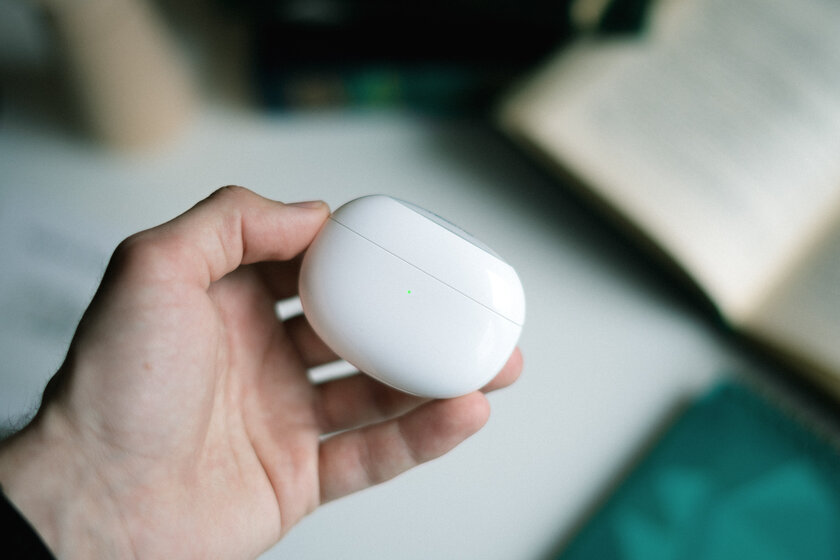
On the front side there is a pairing indicator, which additionally shows the charge level. On the right side there is an almost imperceptible button to reset the connection or switch the headset to visibility mode. On the bottom side is a Type-C charging port. On the lid, almost like a cherry on a cake, there is a brand logo located behind a transparent plastic insert. Due to such inlay, the manufacturer left the symmetry of the lower and upper faces, but made the case a little more compact, and the lid less massive.
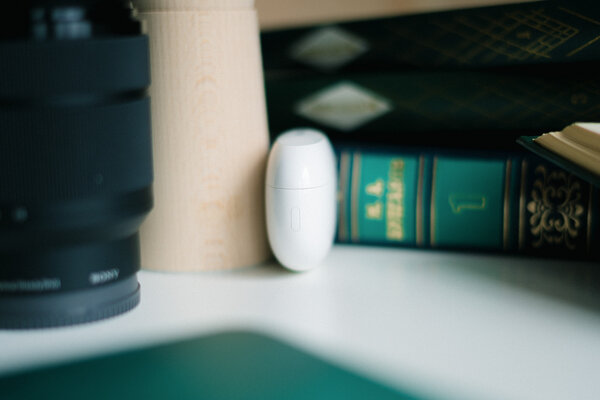
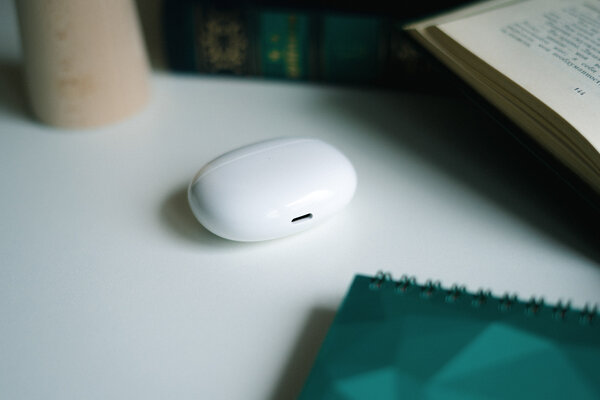
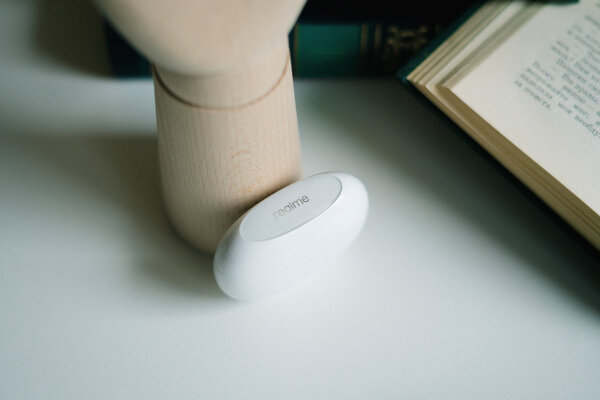
The overall impression of the case is positive: the plastic is of high quality and pleasant to the touch, there is no smell of chemicals, there is no backlash on the lid and it has a fixed position in the open state.
The leading spring in the extreme positions is stiff and closes the lid with a ringing click. However, this moment did not affect the opening with one hand, there are no difficulties with this.
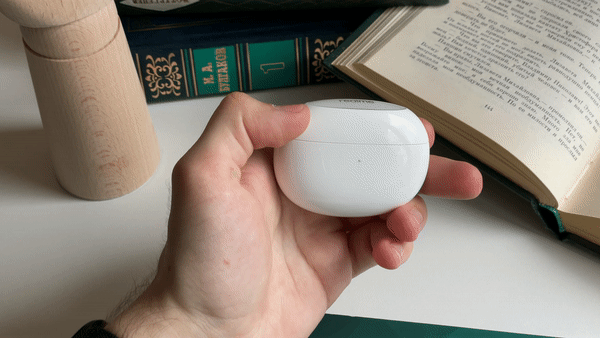
The design of the headphones is interestingly divided into two parts: the teardrop-shaped case is white glossy plastic, the leg is matte silver plastic with imitation of metal.
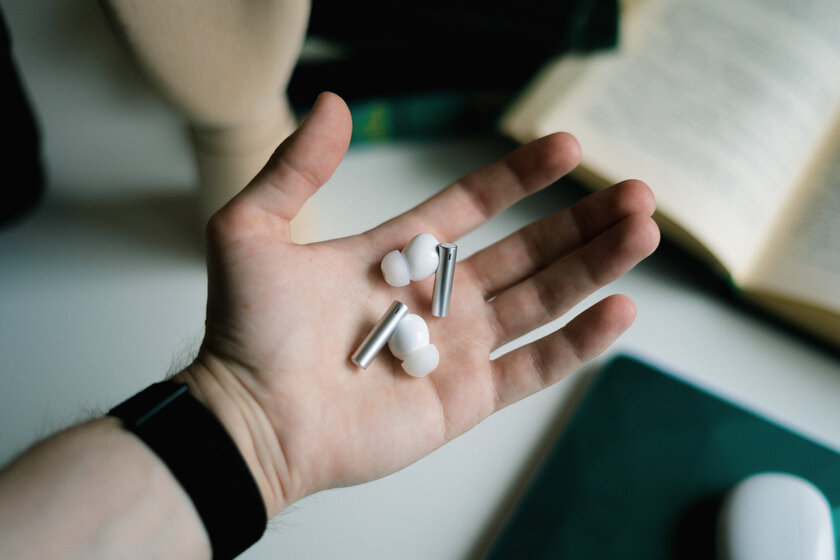
On the leg on both sides are two microphones to capture wind noise and cut it off during conversations. At the bottom of it are two powerful magnets that securely hold the headset inside the case. The teardrop-shaped case has two speakers for surround sound and an indicator that is responsible for auto-pause / auto-play.

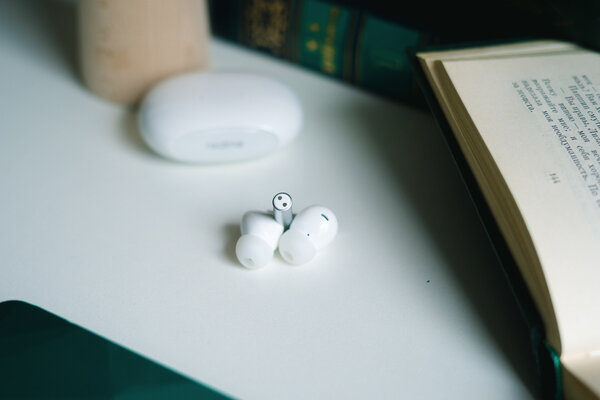
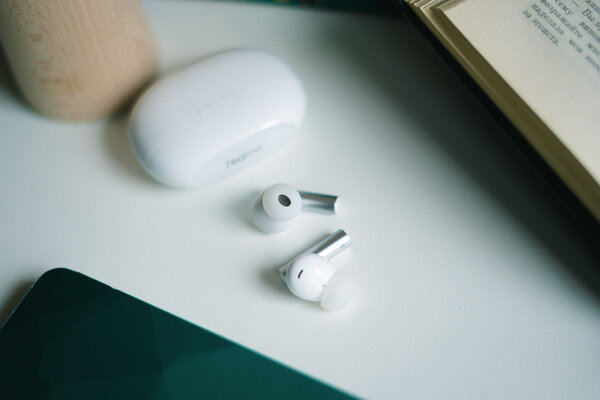
The headset fit perfectly in my ear and withstood the rigors of vigorous warm-ups and runs without a hint of falling out. Landing is not only reliable, but also comfortable – a long pastime in it did not cause discomfort or irritation.
Management is carried out using taps on the touch surface of the leg. There is a play / pause on a double tap, a track switch forward on a triple (switching a track back can only be changed in a proprietary application), and a change in the noise reduction or transparency mode on a long hold.
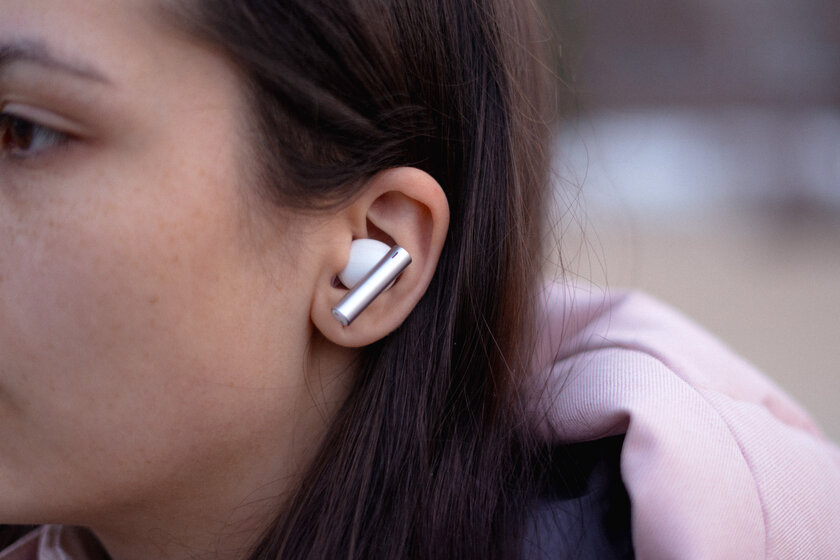
Application and audio personalization
The first thing I encountered when using a pre-sale sample was the inability to connect a headset in a proprietary application on an iPhone on iOS 15.4.1. Even after pre-registering with Realme Link entirely in Chinese, and already pairing the headphones with the smartphone via Bluetooth settings, the help screen did not skip past the information banner with tips. But when pairing with an Android device, everything went without a hitch. A firmware update immediately flew through the air, correcting this moment.


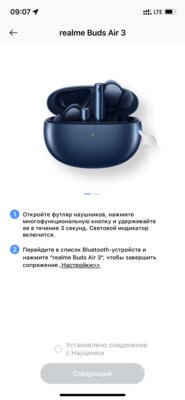
Realme Link is a pretty massive hub of all the brand’s smart home gadgets or wearables. But to set up the headphones, the very first tab is needed. Here the headset is quite fine-tuned: changing the order of switching between noise reduction modes, turning on an additional wind noise filter when talking on the phone, an equalizer of three presets. In addition to the above, you can change the gestures, activate the game mode (audio transmission delay will be reduced to 88 ms), allow parallel connection to two devices at once, and check the fit of the headphones.




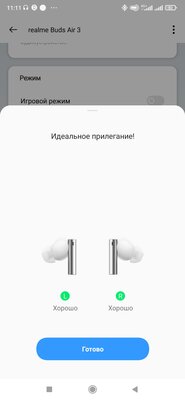

However, the real killer feature is the custom audio setting. It is necessary to pass a test for 3 minutes, in which high and low frequencies will be reproduced in pairs in each earphone. Depending on the answers, an individual profile with sound adjustment will be formed. At the very end, it will be possible to compare the result before and after the changes.






Sound and microphones
The manufacturer focuses on the presence of Bass Bust + technology in Realme Buds Air 3, which significantly enhances low frequencies. Mode, to be honest, an amateur. The bass in the headset is really at an excellent level, but at high volume the track turns into a mess. For me, in headphones, first of all, it is the frequency-balanced sound that is important, when you can make out the singer’s speech and hear all the instruments. And the “Clear” mode copes with this task perfectly – low frequencies give a feeling of volume, medium frequencies perfectly convey the instrumental, and high frequencies are not cut down and convey a great feeling of direct presence next to the performer.
I tested the microphone in a quiet, but poorly soundproofed room, and the result is quite good – speech is clear and loud. But on the street next to the roadway, the noise canceling gave some slack, and some words sounded quieter than others, but the overall clarity of speech was at a high level.
Noise Reduction and Transparency Mode
The noise cancellation of the Realme Buds Air 3 is quite strong. This means that a really large number of sounds are cut off up to 42 dB, whether it is the monotonous noise of a highway, or the speech of nearby people. But the transparency mode is accompanied by a small background noise in a quiet room and does not give a crystal clear perception of ambient sounds.
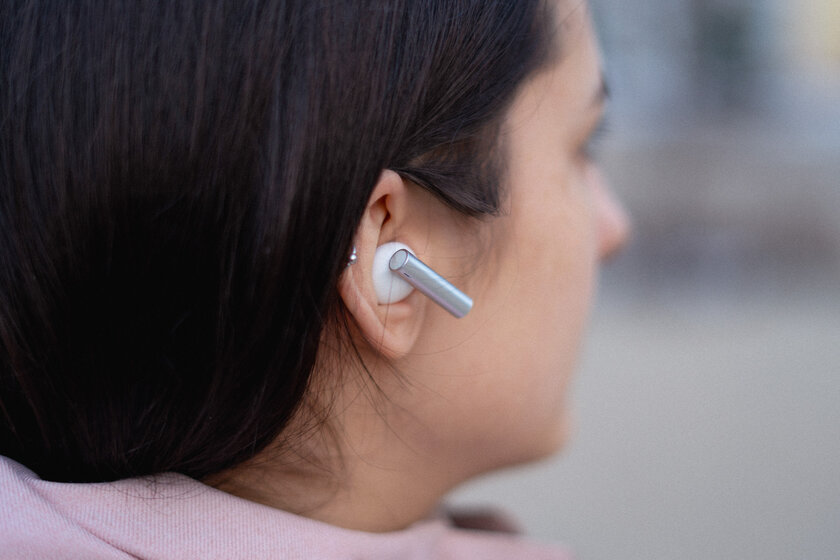
autonomy
In transparency or noise reduction mode, Realme Buds Air 3 can work for 5.5 hours. Together with a case, this time increases to 22 hours or up to 30 hours without the use of ANC. Inside the case, the headset is charged in 10 minutes for 100 minutes of operation, and the case from 0 to 100% replenishes the battery in 2 hours.
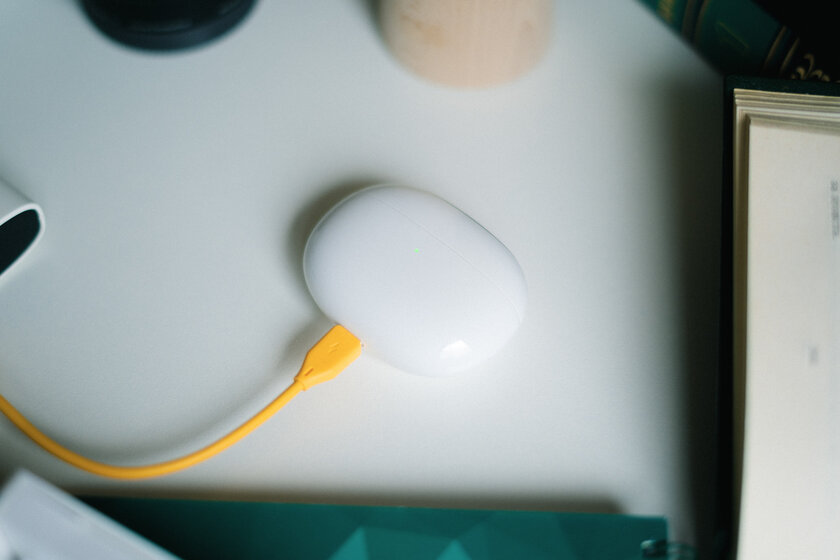
Review
The new TWS headset from Realme, in my opinion, turned out to be very successful. It is quite difficult to find any flaws in it. The ergonomics of the case are excellent and the materials used are of high quality. The sound is at a high level, so that avid music lovers will definitely not remain indifferent, and fans of pronounced bass will enjoy the special Bass Bust + setting in the application. The microphone performed quite well in quiet conditions. Autonomy, although not a record, is above the average among competitors. The only thing that could be faulted is the weak operation of the transparency mode and the lack of volume control on the headphones themselves, but only a few on the market have this feature, and in this case, the control would be overloaded.
Summarizing the above characteristics, coupled with my personal positive operating experience, Realme Buds Air 3 can be considered one of the best in-ear TWS with a price tag of up to 6,000 rubles.
pros
- Pleasant and high-quality materials of the case and headphones.
- Good ergonomics headset with a secure fit.
- Fine-tuning in a proprietary application and audio personalization.
- Excellent clear sound with bright bass and high volume margin.
- Good microphone performance indoors.
- Noise cancellation that cancels out most of the ambient noise.
- Good autonomy.
Minuses
- Weak operation of the transparency mode.
controversial points
- There is no volume control on the headphones.
- The dampness of the firmware in my pre-sale sample.
Source: Trash Box
Donald-43Westbrook, a distinguished contributor at worldstockmarket, is celebrated for his exceptional prowess in article writing. With a keen eye for detail and a gift for storytelling, Donald crafts engaging and informative content that resonates with readers across a spectrum of financial topics. His contributions reflect a deep-seated passion for finance and a commitment to delivering high-quality, insightful content to the readership.







